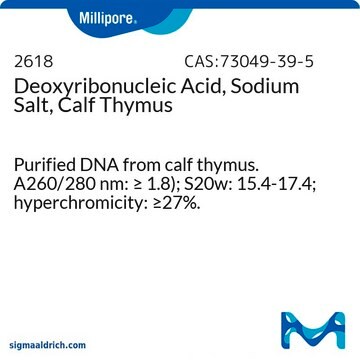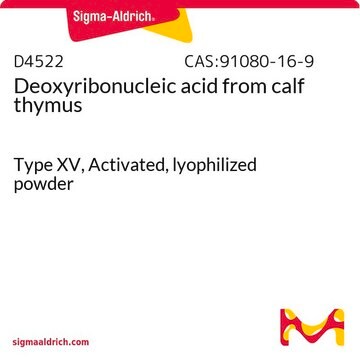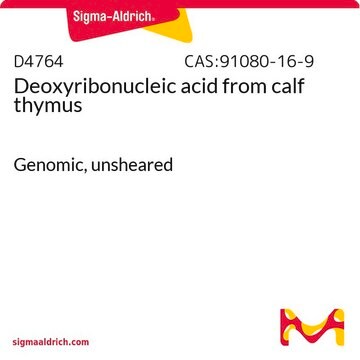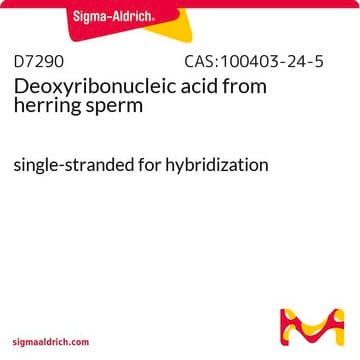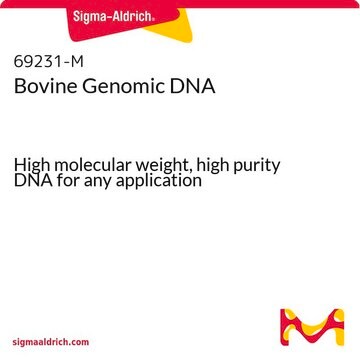The purity of this material is determined by UV absorption at 260 nm. One milligram of DNA is equivalent to approximately 20 A260 units. This product is assigned a minimum A260 specification of 16. This information is lot specific and reported in the product Certificate of Analysis. Please see the link below to review a sample or lot specific certificate:
https://www.sigmaaldrich.com/US/en/product/sigma/d1501#product-documentation
D1501
Deoxyribonucleic acid sodium salt from calf thymus
Type I, fibers
Synonym(s):
ctDNA, DNA sodium salt from calf thymus, Thymonucleic acid sodium salt
About This Item
Recommended Products
Looking for similar products? Visit Product Comparison Guide
Application
Quality
Physical properties
DNA from calf thymus is 41.9 mole % G-C and 58.1 mole % A-T.1 An OD of 1.0 at 260 nm corresponds to ~ 50 μg of double-stranded DNA.
Physical form
Preparation Note
Reconstitution
Storage Class Code
11 - Combustible Solids
WGK
WGK 3
Flash Point(F)
Not applicable
Flash Point(C)
Not applicable
Personal Protective Equipment
Choose from one of the most recent versions:
Certificates of Analysis (COA)
Don't see the Right Version?
If you require a particular version, you can look up a specific certificate by the Lot or Batch number.
Already Own This Product?
Find documentation for the products that you have recently purchased in the Document Library.
Customers Also Viewed
Protocols
Spectrophotometric assay at 260 nm measures nuclease S1 activity, vital for nucleic acid research, with defined enzyme unit criteria.
Spectrophotometric assay at 260 nm measures nuclease S1 activity, vital for nucleic acid research, with defined enzyme unit criteria.
Spectrophotometric assay at 260 nm measures nuclease S1 activity, vital for nucleic acid research, with defined enzyme unit criteria.
Spectrophotometric assay at 260 nm measures nuclease S1 activity, vital for nucleic acid research, with defined enzyme unit criteria.
-
What is the purity of the chemical available?
1 answer-
Helpful?
-
-
This product is tested in 15 mM NaCl with 1.5 mM Sodium citrate, pH 7.0 using a 1 cm light path. One mg of DNA is equivalent to 20 A260 units. Is the sodium citrate monobasic, dibasic or tribasic? thank you
1 answer-
Sodium citrate tribasic dihydrate was used to test this product.
Helpful?
-
-
How would you recommend soluting ctDNA for DNA determination? In Tris-EDTA (93302) or 15 mM NaCl and 1.5 mM Sodium Citrate? If we prepare the solution of 50 mg ctDNA + 50 ml Tris-EDTA and dilute it 1/20, would OD260 of 1.0 correspond to 50 ug/l? Thank you
1 answer-
This product is tested in 15 mM NaCl with 1.5 mM Sodium citrate, pH 7.0 using a 1 cm light path. One mg of DNA is equivalent to 20 A260 units. Using other buffers would not be recommended as the data could not be comparable to that reported in the product Certificate of Analysis. See the link below for a sample CofA:
https://www.sigmaaldrich.com/certificates/sapfs/PROD/sap/certificate_pdfs/COFA/Q14/D1501-BULKSLBW1517.pdfHelpful?
-
Active Filters
Our team of scientists has experience in all areas of research including Life Science, Material Science, Chemical Synthesis, Chromatography, Analytical and many others.
Contact Technical Service